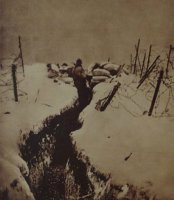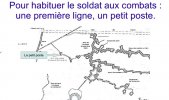- The nights in small stations.
- • There are often two or three soldiers with an officer being at a sentinel station, situated several meters or tens of meters in front of the front line trenches. In the middle of barbed wire, they are responsible for scanning the night in order to detect adverse movements, thwart "raids", post jobs saps and crouch under the flares. These stations are always described as harsh.
- • They are not allowed to fall asleep otherwise this fault will inevitably be punished by the designation for helping in the opposing trench or for doing a more dangerous mission like going out of the trench for the assault .
- • In reality these structures were dug at night by the Engineering or soldiers. Bomshell holes could also be used for this purpose.
 Site officiel de"Vallée de la Cisse" : étudier de manière pluridisciplinaire les questions culturelles et diffuser les résultats des recherches par divers moyens sur nos 18 communes fédérées de la Vallée
Averdon - Chambon-sur-Cisse - Chouzy-sur-Cisse - Coulanges - La-Chapelle-Vendômoise - Fossé - Landes-le-Gaulois - Marolles - Mesland - Molineuf - Monteaux - Onzain - Orchaise - St-Bohaire - St-Lubin-en-Vergonnois - St-Sulpice-de-Pommeray - Seillac - Veuves
Site officiel de"Vallée de la Cisse" : étudier de manière pluridisciplinaire les questions culturelles et diffuser les résultats des recherches par divers moyens sur nos 18 communes fédérées de la Vallée
Averdon - Chambon-sur-Cisse - Chouzy-sur-Cisse - Coulanges - La-Chapelle-Vendômoise - Fossé - Landes-le-Gaulois - Marolles - Mesland - Molineuf - Monteaux - Onzain - Orchaise - St-Bohaire - St-Lubin-en-Vergonnois - St-Sulpice-de-Pommeray - Seillac - Veuves
Home > A-LES SABLONNIERES, tranchées d’entraînement, field of fortifications, des (...) > La composition du terrain d’entraînement > 10 - The small post -
Translated by Nathalie GAUTHIER
You can see how far this guard stations are from the front line.
Almost all letters written by the poilus and writings made by soldiers coming back from this "hell" talk about these moments, tense with fear, and for which men were often designed to occupy those positions.
(vu par 207 visiteurs)


